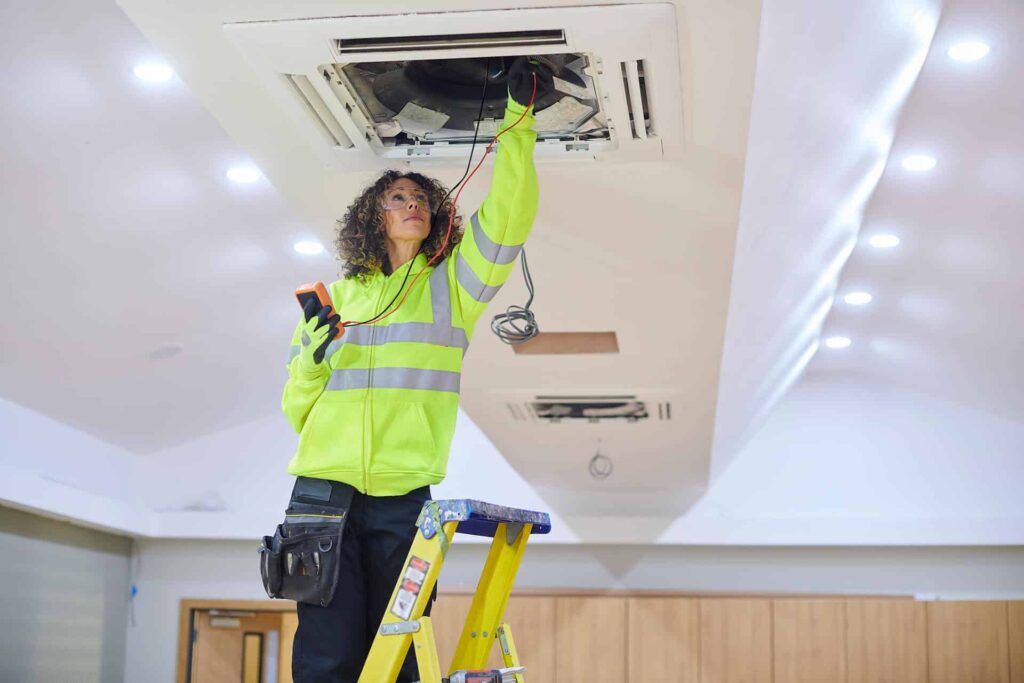Overcoming the FM Gender Gap

Sundt Construction’s Ellisa De Rosa discusses her success in FM and shares her opinions on the existing gender gap.
Changing the perception of women in the workplace has been an uphill battle and despite some progress in a handful of industries — it continues to be a struggle. Facilities management is a professional field that has yet to successfully close the gender gap despite an increased awareness in recent years.
Ellisa De Rosa, Corporate Director of Facilities and Office Services for Sundt Construction, is a woman making her mark in the predominantly male-dominated worlds of FM and construction. Her goal is to get both men and women to understand their gender nuances in order to create better communication and collaboration in the workplace that will result in an environment where everyone can thrive.
Could you start off by telling us a little bit about your professional background and how you initially got into FM?
De Rosa: I started in 2008 and kind of fell into it — like the majority of the FM population. I was hired on at Sundt Construction as the Office Services Supervisor and my boss, who had been there for 42 years, announced three months after he’d hired me that he was retiring. He recommended me to be his successor. I said, “okay, what do you do?”
I shadowed him for about three months and he gave me some good resources and pointed me towards a couple organizations, one of which was IFMA, then kind of set me free when he retired. I had to learn how to do everything. My boss is the Chief Administrative Officer, so I am the top position in the facilities department at my company. I had to learn as much as I could in a very short period of time. When I joined IFMA, I dove into the education part of it. I earned my FMP within three years, my CFM in five years and I just received my CM-Lean certification for construction this year.
I attribute my opportunities to Sundt for opening the door. However, the majority of my professional knowledge and growth is due to IFMA because I was in the position with no facilities mentor or guide. Thankfully I work for a construction company, so we have a lot of people on the construction side that were able to help. However, new construction and facilities are very different, so that was a steep learning curve as well.

Your department won the 2015 Professional Company of the Year Award and you were named the Professional Member of the Year by the IFMA Greater Phoenix Chapter that year as well. How are you able to maintain that high standard of FM practice?
De Rosa: I hold myself to a very high standard and I expect to continue growing and improving. I feel very strongly about giving back to my community. We do a lot of things to help our profession in general. I am very focused on customer service and believe that the better you treat people, vendors and partners, the better results you will have.
I do hold everyone to a high standard as well. I am very open, forward and blunt with my expectations, but I’m also very loyal. I think all of those things contribute to our continuing success. Because we have a lot of outsourcing that we do here, we have partners we rely on that become very embedded and invested in our team. I think it’s the relationships that my team and I create within the department that has made a good working atmosphere — I like to focus on the people aspect of it.

Could you give us some overall insight into the FM gender gap between men and woman and when did you first start noticing that this was prevalent in the industry?
De Rosa: The idea that men and women are equal in the workplace is a widespread ideal wanted and needed in a lot of industries, however, I think there’s still a gap. We are not equal, we are not created equal, we don’t act equal. There’s lots of things for us to do in order to be able to collaborate with each other and work really well together to hone in on the strengths both men and women have.
When I came to work at Sundt, I could see the gender gap in both construction and FM. In the construction industry, according to the National Association of Women in Construction (NAWIC) in 2014, only 8.9 percent were women. I can see this in my workplace, even though Sundt employs a higher percentage of women than the industry norm.
I looked into property, real estate and community association managers because FM is not a known industry yet. The ISO standard just recently passed. However, property, real estate and community association managers were still down at about 47 percent women in 2014. The numbers speak for themselves.

Why do you think the FM gender gap has remained prevalent throughout the years despite an increased awareness of the issue?
De Rosa: I think there is definitely a lack of understanding in how to approach it. I think the gap in the construction industry is due to the labour and the craft. There’s a lot of hard physical work that goes into building and it’s a male-dominated field. That does not mean women cannot do it, that’s just a stereotypical view.
When it comes to facilities, it’s a fairly new field. It started with technicians, again you have the craft and the blue-collar workers who are working there. Sometimes, these positions are viewed as “dirty jobs.” The more you get into management and administrative positions, you see more women because that’s the stereotypical woman’s job. That’s kind of where those numbers have come from historically. The more education we get out to our younger generation on what the reality is in facilities, they’ll realize more women are needed because it’s not just a physical job — it’s more of a management and leadership job. I think it’s shifting in the right direction, it’s just going to take a while to get over those stereotypical ideas.

How can men be part of the gender gap solution and what should they understand about their role in the issue that they may not even realize?
De Rosa: In business, generally speaking, history shows that women stayed home with the kids and men went to work. A hundred years ago, the United States had more self-owned businesses than public ones, so it’s flipped majorly now and men have shaped the way that the market and businesses run. Businesses are run in a very male fashion, meaning men are very focused on the end goal, the one task that they need to get done and everything revolves around that. It’s modelled after this entire generation of history that has shaped our businesses.
Women coming in think very differently. They think about the journey and the end goal. Because women tend to be more team-orientated in general, we like to collaborate, get people’s input, ask for help, include everybody. Sometimes that can create a different dynamic. If you have both, you’re going to get a really good end result, however, the traditional workplace was not designed for women. It was designed with the male idea of “this is our meeting, this is our end goal, this is our focus and now let’s go to the next thing.” Women would take more time to figure out how to get to that goal and maybe not have as much re-work as men would.
Both of these situations have real validity. However, they are extremely different viewpoints. Men are more task-focused and women are more team-focused. When misunderstood, this can cause misinterpretation and miscommunication. When understood and used effectively, these views can create very good synergy.

Do you have any tips that men and women should keep in mind in order to bridge the gender gap in a collaborative work environment?
De Rosa: The number one key is to grow your gender intelligence. If you really learn to grow your knowledge of the opposite sex, you can learn how to communicate with them better. If either side takes a minute, sits down and just stops to look at alternative views and puts themselves in the other person’s shoes, they will understand more of how the other person acts.
Communication is also crucial. What that means, in a deeper context, is men should learn to ask more questions than they’re used to asking, and maybe sit down and really think about why they want to know this? Women need to understand that men tend to be very frank, to-the-point, determined, goal-oriented and task-oriented. We can start to bridge that gap by really understanding each other’s point-of-view. We will be better able to take ownership in our own ways of thinking and talking to be able to alternate those views and change the way we communicate with each other — if we can do that, we’ll all get along much better.
Follow Ellisa on LinkedIn and check out Sundt Construction to learn how they can help you with your commercial construction needs.
How do you think the gender gap in FM should be approached? Join the conversation and leave us a comment below.
Photos: Rawpixel, Pixabay, Rawpixel, Juhasz Imre, Startup Stock Photos




